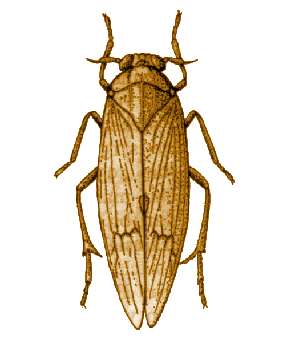Brown planthopper facts for kids
Quick facts for kids Nilaparvata lugens |
|
|---|---|
 |
|
| Scientific classification | |
| Genus: |
Nilaparvata
|
| Species: |
lugens
|
The brown planthopper (BPH), also known as Nilaparvata lugens, is a tiny insect. It's a type of planthopper that loves to feed on rice plants. These insects are a big problem for rice farmers. Rice is a super important food for billions of people around the world.
Brown planthoppers harm rice plants in two main ways. First, they damage the plants by feeding on them. Second, they can spread two plant viruses: rice ragged stunt virus and rice grassy stunt virus. If many planthoppers attack, farmers can lose up to 60% of their rice crop.
You can find the brown planthopper in many countries. This includes places like Australia, China, India, Japan, the Philippines, Thailand, and Vietnam. Besides rice, they can also feed on a wild grass called Leersia hexandra.
Contents
How Brown Planthoppers Live
Brown planthoppers come in two forms. One form has full wings (called 'macropterous'). The other has short, stubby wings (called 'brachypterous').
Winged Travelers
The full-winged planthoppers can fly long distances. They are the ones that find and settle on new rice fields. Once they land, they start a new family. Most of the female planthoppers born in this new group will have short wings. Most of the males will have full wings.
Life Cycle
Adult planthoppers usually mate right after they grow up. Females start laying eggs the very next day. Short-winged females lay many more eggs (300 to 350) than full-winged females. They lay their eggs in a straight line, usually inside the rice plant's leaf sheath.
The eggs hatch in about six to nine days. The tiny baby planthoppers, called nymphs, are white at first. They turn purplish-brown within an hour. Nymphs drink sap from the rice plants. They grow through five stages before they become adult planthoppers.
Damage to Rice Plants
Brown planthoppers can attack rice plants at any stage of their growth. Both the nymphs and adults feed at the bottom of the rice stems. When they do this, the plants turn yellow and dry out fast.
Hopper Burn
In the early stages of an attack, you might see round yellow patches in the rice field. These patches soon turn brownish as the plants dry up. This damage is called 'hopper burn'. It looks like the plants have been burned.
Temperature Effects
Temperature is very important for these insects. Eggs hatch best and nymphs survive most around 25°C (77°F). If the rice plant starts to wilt, the eggs dry up quickly. Brown planthopper populations grow fastest when the temperature is between 28°C and 30°C (82°F to 86°F).
Natural Enemies
Many creatures help control brown planthopper numbers. Some spiders, like Pardosa pseudoannulata and Araneus inustus, hunt and eat them.
Sometimes, planthoppers lay eggs in rice seed beds. These are special areas where young rice plants grow before being moved to the main field. This means the planthoppers can enter the main field along with the young rice plants.
Managing and Controlling Planthoppers
Using too much urea fertilizer or too many insecticides can actually make brown planthopper problems worse. This is because these chemicals can help the planthoppers lay more eggs. They can also harm the insects that naturally eat planthoppers.
Integrated Pest Management (IPM)
A better way to control these pests is called integrated pest management (IPM). This approach tries to limit the use of too much fertilizer and harmful insecticides. For example, in 2011, the government in Thailand limited certain insecticides. This was to help control a big planthopper outbreak. The International Rice Research Institute (IRRI) supported this decision. IRRI also has plans to help farmers manage planthopper outbreaks using IPM.
Resistant Rice Varieties
Growing rice varieties that are naturally strong against brown planthoppers is also important. For example, a rice type called IR64 can help prevent outbreaks. However, in places where farmers don't use many insecticides, very high resistance might not be needed.
Scientists are also trying to find new ways to control planthoppers. They are looking into ways to turn off specific genes in the planthoppers. These genes are important for their digestion or defense. Some plant proteins, called lectins, can stop planthoppers from feeding. If used correctly, these could protect rice plants.
Climate Change Impact
Studies show that young brown planthoppers (nymphs) are already living at the highest temperatures they can handle. This means that if tropical regions get even hotter, with very extreme temperatures, it could make it harder for brown planthoppers to survive and spread.

